Projects
Research and innovation at The Bridge Studios, UWE Bristol.
Seed funding of £120,000 has been allocated to six projects to explore the potential of The Bridge Studios.
Projects
Sensing Music Interactions from the Outside-In
The Outside Interactions project, as part of the MICA Lab, is supported by a UKRI Future Leaders Fellowship and will explore a novel approach to human computer interaction along with new methods for co-designing digital musical instruments (DMIs) with non-technical and physically impaired musicians.
The project takes a disruptive and inclusive approach that that will reshape the fundamental practice of DMI design, inviting broader participation in the development of new musical instruments and future visions of musicianship.
The development of musical instruments and gestural music interaction are often considered and pursued separately. By focusing on musical objects, instrument development is often considered a technical challenge assuming normative players and overlooking the diversity of musicians, audiences, and their environments. Gestural music interaction has shown great potential for music performance and accessibility; however, it neglects the significant role of tactile feedback in music training and the development of virtuosic performance.
The Outside Interactions project will take a holistic approach, coupling gestural interaction and physical prototyping, departing from the conventional practice of embedding sensing technologies within an instrument and relocating the technology onto the body, sensing player interactions using wearable devices on the wrist and hand. A radical switch in both technical and design approach that opens innovative new research directions for low-cost, rapidly produced musical instruments, which can be designed to have any shape, scale or structure.
Crucially, this provides new ways for people to participate in the rapid co-design of novel, customised musical instruments that are tailored to their unique artistic identity and access requirements.
Project team
Prof Tom Mitchell, Dr Dominic Potts, Dr Seb Madgwick, Maisie Palmer, Hugh Aynsley.
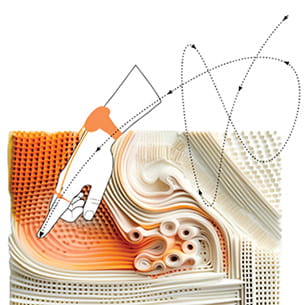
Adaptive Fenestration Design Using 3D-Printed Earthen Materials for Climate Control in Architecture
This project builds on state-of-the-art research in 3D-printed cob, including British cob mixtures developed at Cardiff University and UWE Bristol’s Centre for Fine Print, and self-shaded fenestration concepts explored by the British University in Egypt. While these studies have advanced material and design knowledge, they lacked full-scale, performance-based fenestrations using robotic 3D printing.
This research aims to fabricate an innovative fenestration system utilizing parametric methods and robotic arm printing, enabling free-form designs with adaptable shading and airflow characteristics. Tailored to British climates, this project establishes a scalable framework for future bids, exploring parametric adaptability to diverse climates and enhancing sustainable architectural performance.
Project team
Dr Anas Lila, Dr Deena Elmahdy, Pasha Jeremenko, Tianhao Ji.

Your Tools, Your Way: Empowering Neurodivergent Creatives through Co-Design and Personal Fabrication
This project engages neurodivergent creatives - including digital artists, designers, and musicians - in a co-design process to develop personalised creative tools. Using The Bridge, we will explore materials and fabrication techniques that enhance their unique practices.
Key objectives include understanding neurodivergent needs, empowering participants through meta-design principles, and developing multi-sensory tools that enhance usability and creativity. Additionally, we will investigate deformable and shape-changing interfaces to create adaptable tools, leveraging emerging technologies for innovative design solutions.
By fostering inclusivity and innovation, this project aims to support neurodivergent creatives in fully expressing their potential. Through collaboration, we seek to develop tools that align with individual creative workflows, ensuring accessibility and effectiveness. The research will contribute to a broader understanding of how adaptable, multi-sensory tools can transform creative practices, ultimately shaping more inclusive design methodologies.
Project team
Dr Cameron Steer, Dr Jac Fennell, Dr Kim Sauvé, Dr Ollie Hanton, Dr Sarah Campbell.
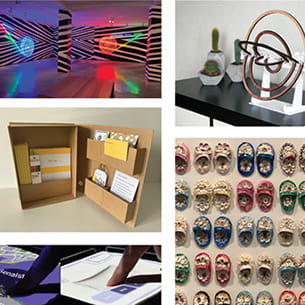
Exploring mixed reality as a new medium for live music performance
Introspect explores a new medium for music performance using extended reality (XR) technology to enhance immersive visuals and audience interaction.
XR headset sensing technology measures audience interaction to create reactive visuals seen by the entire audience within the performance space. This medium aims to connect the audience and performer in real time, bridging the gap formed by algorithmic playlists and the decline of physical music items. By being part of an XR audience, attendees collaborate with the artist in real time.
UWE Bristol’s Centre for Machine Vision and Bristol Robotics Laboratory’s alumni Octopus Immersive Laboratory are developing a real-time motion tracking system, enabling performers to orchestrate mixed reality scenes and enhance immersion. Using contemporary machine learning techniques, a gesture tracking system will infer performer intent, translating it to a digital avatar that orchestrates scene visuals, making the performer a puppeteer of both the scene and the avatar.
Project team
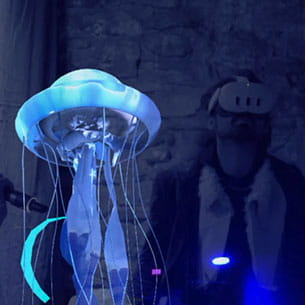
Platinum Structures for In-situ Crystal Growth
This project aims to improve crystal growth technologies by innovatively producing bespoke platinum structures and crucibles. By leveraging advanced digital fabrication techniques, specifically the Meltio Direct Energy Deposition (DED) metal 3D printing technology integrated with the HAAS 5-axis CNC machine, we will design and produce intricate platinum structures incorporating gemstone seeds to catalyse crystal growth, and bespoke platinum crucibles that will improve growth environments.
The project will not only enhance our understanding of platinum's capabilities in relation to its fabrication in this setting, which has to date not been tried, but also has the potential to enable more sustainable and cost-effective production for crystal growth purposes.
Collaborating with Meltio, we aim to deliver an exemplar for bridging the gap between academic and industrial research and development, promoting the application of creative innovations while setting the stage for real-world advancements with considerable commercial impact by re-imagining the way we utilise platinum for crystal growth.
Project team
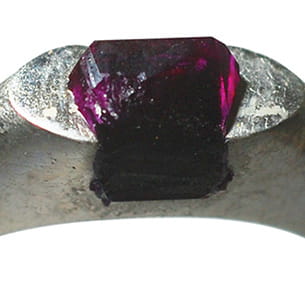
Large scale tele-operated paintings beyond the capacity of a human
This project uses a six-axis Kuka robot arm to replicate human painting styles by translating recorded human movements from the Vicon motion capture system and virtual-reality-created artwork into precise robot movements, with small variations.
This innovative method enhances bulk print production by introducing unique differences and valued scarcity on a large scale. It removes traditional artistic constraints related to an artist’s physical size and style, increasing artistic freedom and inclusivity.
The project aims to use Bridge equipment for motion capture to collect a dataset of painting movements while creating artwork in virtual reality (VR), then develop an artificial intelligence (AI) model to translate them into robot instructions for the KUKA arm to paint with. This showcases potential for large-scale tele-operated paintings in human style and unique artefacts for bulk reprint processes. Success could lead to using the robot as a co-artist, incorporating trending news or climate data using image generation AI.
Project team
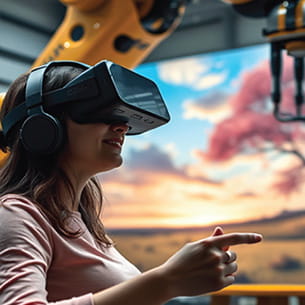
Ritual Virtual: Inside the sacred rites
The sacred rituals of the Eleusinian Mysteries, dedicated to the cult of Demeter and Persephone, were observed for millennia in ancient Greece. This elaborate series of rites and ritual preparations helped initiates overcome fear of death and achieve their best life.
Ritual Virtual is an immersive theatre experience which employs live performance, video projections, choreographed robots and virtual reality (VR) to allow audience members to enter the initiation.
This was the first production by the Duvet Brothers since their pioneering work as video artists in the 1980s. Rik Lander is a Senior Lecturer at UWE Bristol specialising in participatory and interactive media. Peter Boyd Maclean is a director specialising in virtual reality.
They ask, can VR and robotics, alongside theatrical staging, create profound first-person emotional resonances with a dramatic narrative?
It was staged in T-block on Frenchay Campus on 19 and 20 June 2025 and was open to UWE staff, students and the public.
Project team
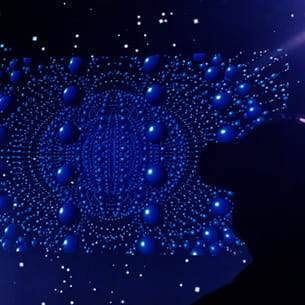
You may also be interested in
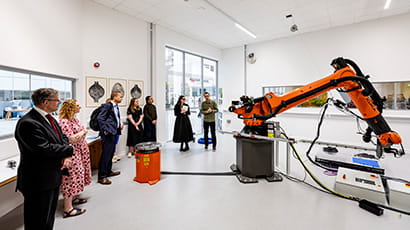
Facilities and equipment
Facilities and equipment available at The Bridge Studios, UWE Bristol.
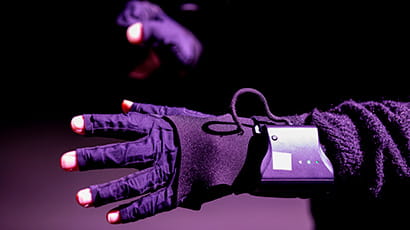
Immersive Studio and performance space
Immersive Studio and performance space at The Bridge Studios, UWE Bristol.

Robotic Fabrication Lab
Robotic Fabrication Lab at The Bridge Studios, UWE Bristol
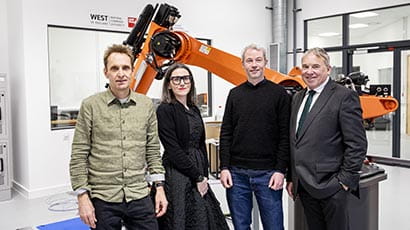
Contact us
How to find The Bridge Studios at UWE Bristol.
